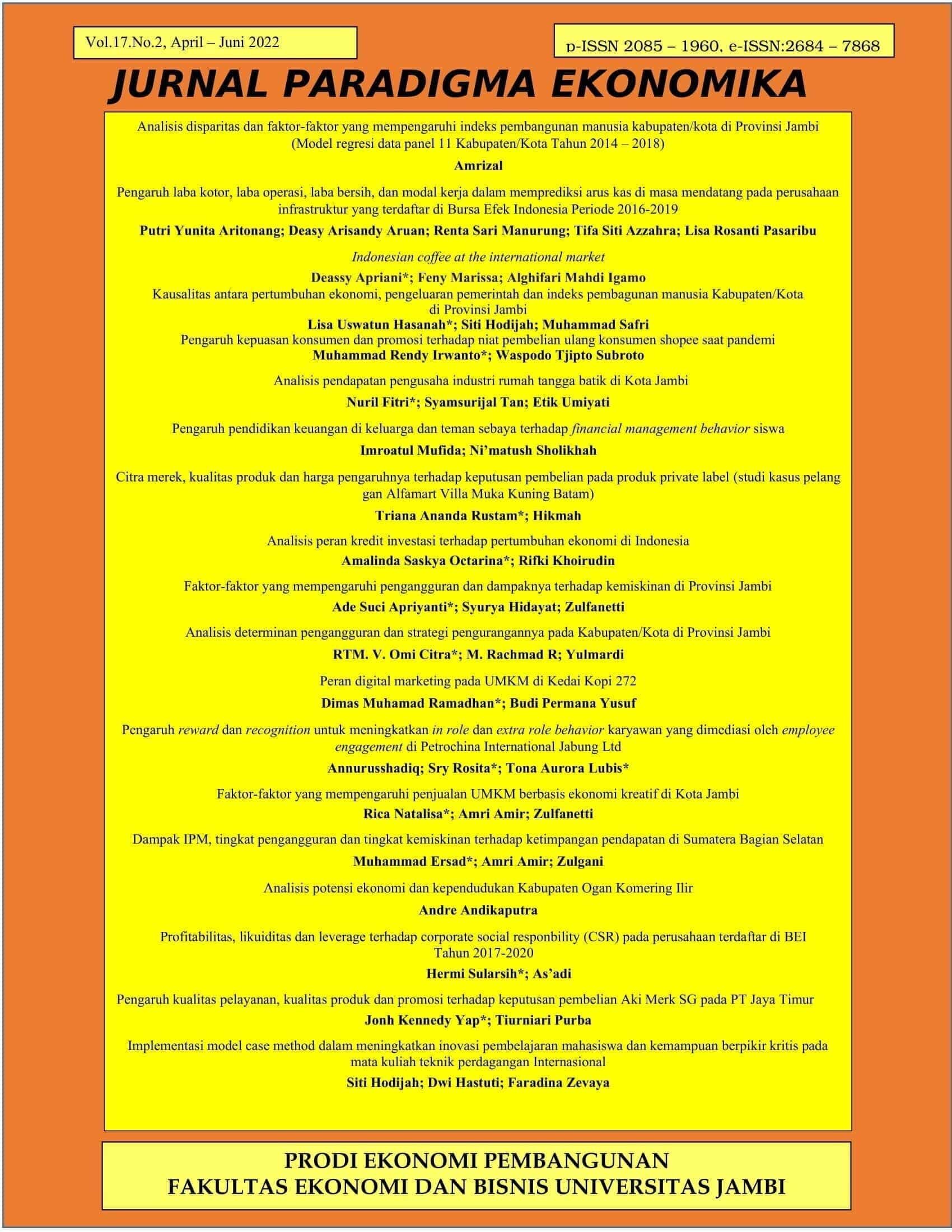Analisis potensi ekonomi dan kependudukan Kabupaten Ogan Komering Ilir
DOI:
https://doi.org/10.22437/jpe.v17i2.16428Keywords:
location quotient, shiftshare, dependency ratio, potential economicAbstract
The government must be able to maximize the economic potential of the region. it can be accomplished through understanding the sectors that support economic growth. Population conditions also have a relationship with economic growth. The government of Ogan Komering Ilir has to understand the basic sector that will encourage an increase in the GRDP of the region so that it can support the economy of the region. The purpose of this research is the analysis of the potential sector and population should be a guide for planning and development, especially economic growth in Ogan Komering Ilir. The results showed that only the agricultural, forestry and fisheries sectors was the only basic sector in Ogan Komering Ilir. Furthermore, the population growth rate for the 2015-2019 period was 1.32% which was not too high in Ogan Komering Ilir Regency. Also, the population that is the burden of the productive population looks stagnant.
Downloads
References
Acemoglu, D. (2012). Introduction to economic growth. Journal of Economic Theory, 147(2), 545–550. https://doi.org/10.1016/j.jet.2012.01.023
Almeida, R., & Fernandes, A. M. (2013). Explaining local manufacturing growth in Chile: The advantages of sectoral diversity. Applied Economics, 45(16), 2201–2213. https://doi.org/10.1080/00036846.2012.659344
Ayubi, & Affan, A. (2014). Analisis Potensi Ekonomi Kabupaten Banyuwangi. Jurnal Ekonomi Pembangunan, 12(1), 1–1.
Chenavaz, R., & Escobar, O. (2015). Population distribution, effective area and economic growth. Applied Economics, 47(53), 5776–5790. https://doi.org/ 10.1080/00036846.2015.1058907
Franklin, R. S. (2014). An Examination of the Geography of Population Composition and Change in the United States, 2000–2010: Insights from Geographical Indices and a Shift–Share Analysis. Population, Space and Place, 20(1), 18–36. https://doi.org/10.1093/icc/2.1.451
Hardati, P. (2013). Pertumbuhan penduduk dan struktur lapangan pekerjaan di Jawa Tengah. Forum Ilmu Sosial, 40(2), 219–229. https://doi.org/10.15294/ fis.v40i2.5363
Iyer, S., Kitson, M., & Toh, B. (2005). Social capital, economic growth and regional development. Regional Studies, 39(8), 1015–1040. https://doi.org/10.1080/ 00343400500327943
Lee, C. C., & Lin, C. W. (2018). Economic growth, financial market, and twin crises. Journal of International Trade and Economic Development, 27(8), 937–967. https://doi.org/10.1080/09638199.2018.1477824
Mehregan, N., Asgary, A., & Rezaei, R. (2012). Effects of the Bam earthquake on employment: A shift-share analysis. Disasters, 36(3), 420–438. https://doi.org/ 10.1111/j.1467-7717.2011.01268.x
Pujoalwanto, B. (2014). Perekonomian Indonesia tinjauan historis, teoritis, dan empiris.
Schumacher, F. I., Dias, J., & Tebaldi, E. (2014). Two tales on human capital and knowledge spillovers: the case of the US and Brazil. Applied Economics, 46(23), 2733–2743. https://doi.org/10.1080/00036846.2014.909575
Tarigan, R. (2005). Teori dan aplikasi ekonomi regional. Edisi Revisi. Bumi Aksara: Jakarta.
Yip, P. S. F., Cheung, K. S. L., Law, S. C. K., Chi, I., & Robine, J. M. (2010). The demographic window and economic dependency ratio in the Hong Kong SAR. Asian Population Studies, 6(2), 241–260. https://doi.org/10.1080/17441730. 2010.494452
Yulianita, A. (2009). Analisis sektor unggulan dan pengeluaran pemerintah di Kabupaten Ogan Komering Ilir. Jurnal Ekonomi Pembangunan, 7(2), 70–85.
Downloads
Published
How to Cite
Issue
Section
License
Copyright (c) 2022 Andre Andikaputra

This work is licensed under a Creative Commons Attribution-ShareAlike 4.0 International License.









